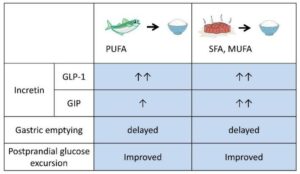Chances are that you’ll soon be sitting down to the annual tradition of a Thanksgiving dinner. As you’re filling your plate, your eyes are darting around at all of your favorite dishes that you see only once a year. Which one do you take a bite of first? I haven’t had Mom’s amazing stuffing since LAST Thanksgiving . . . HURRY, pass the gravy!
Not so fast. Remember that feeling of being uncomfortably full after last Thanksgiving dinner? And the year before? And . . . you get the idea. Perhaps there’s a better approach.

Meal sequencing
The order in which you eat food during a meal can have significant implications to your metabolic health. Specifically, relevant factor about the timing of our food consumption is the order of macronutrient content – protein vs. fat vs. carbohydrate.
Carbohydrates are broken down into glucose (sugar) relatively quickly. Thus, carbohydrates can serve as a rapidly available source of energy. For example, if someone has low glucose levels (perhaps from administering too much insulin), eating carbohydrates can quickly increase the glucose level. That may be a good thing in that situation, but it can be a problem for individuals with baseline glucose levels that are normal or already elevated.
Proteins and fats before carbohydrates
Eating protein or fat before carbohydrates results in decreased food intake and lower elevation of glucose. These effects are driven by increased secretion of the hormone Glucagon-Like Peptide 1 (GLP-1), which is known to suppress appetite and reduce food intake. [You may recognize this hormone as being the mechanism of the blockbuster weight-loss drug semaglutide (aka Ozempic or Wegovy).] GLP-1 also regulates the insulin response to carbohydrate consumption.
In one study, when fish and meat (mixed protein and fat) were consumed before rice (carbohydrate), there was significant reduction in the post-meal glucose spike, increase in GLP-1 secretion, and slowed emptying time of the stomach.

Note also what happens with another important hormone, Glucose-dependent Insulinotropic Polypeptide (GIP, aka Gastric Inhibitory Peptide) in this study. [In addition to GLP-1, the GIP mechanism is the second mechanism found in the weight-loss medication tirzepatide (aka Mounjaro or Zepbound).] There was a significant difference in effect on the GIP secretion between the fish meal and the meat meal, despite similar energy content, nutrient ratio and amino acid composition. Meat (rich in saturated fats) caused a higher increase in GIP than did fish (rich in unsaturated fats).
Protein foods are more satiating than other macronutrients and improve the glycemic response to meals. Thus, it is recommended that protein be the first macronutrient consumed at mealtimes.
Fibrous vegetables before carbohydrates
Though the data is not as robust as for protein and fat, it appears that fibrous vegetable intake early in the meal can also be beneficial. In addition to increased fullness (satiety) from eating low-energy-density fibrous material, eating vegetables before carbohydrates reduces the post-meal increase in glucose from a subsequent carbohydrate load.
A small study showed that any combination of vegetables and meat before rice was preferable in terms of post-meal glucose response. A meal pattern of vegetables, then meat, then rice (V-M-R) stimulated the highest secretion of GLP-1.
In another study, consuming low-calorie salad greens before a pasta meal resulted in decreased total calorie intake compared to eating just pasta.
Summary
Instead of a haphazard approach to eating, a strategic approach to the order in which you eat macronutrients off your plate can be beneficial to your metabolic health. Protein, fat, or fiber should ideally be consumed before carbohydrates in order to limit energy intake and to minimize the glucose response to the carbohydrate content of a meal.
Action items
- Eat protein before carbohydrates – turkey before bread, stuffing, potatoes, yams, etc
- Eat fibrous (non-starchy) vegetables before carbohydrates – generally above-ground vegetables
- Consider pre-load of protein before the main meal
- Delay intake of carbohydrates until later in meal





